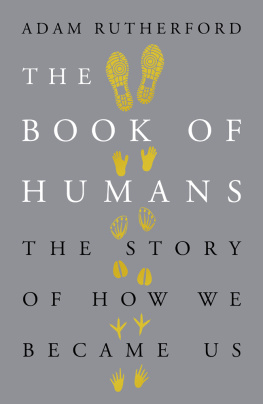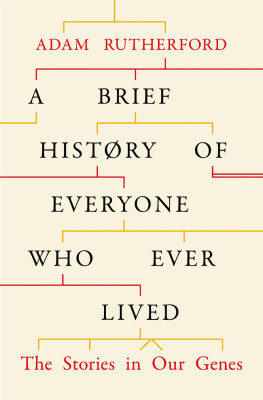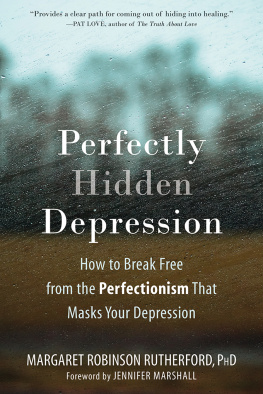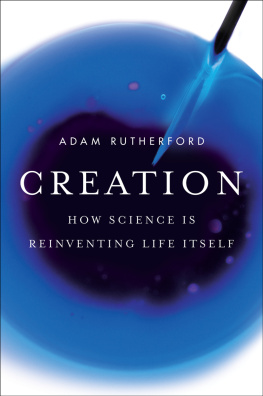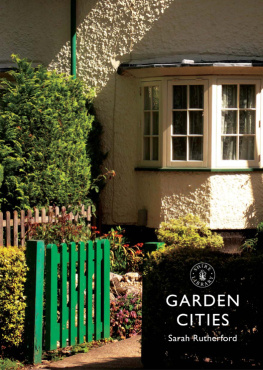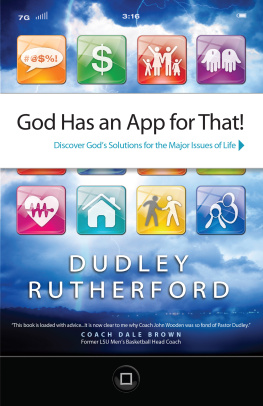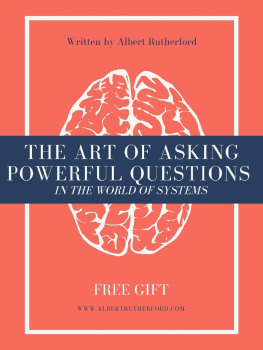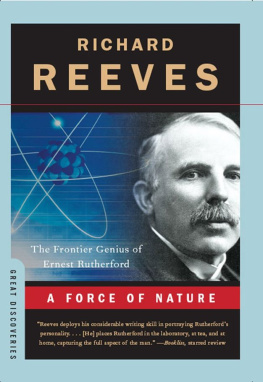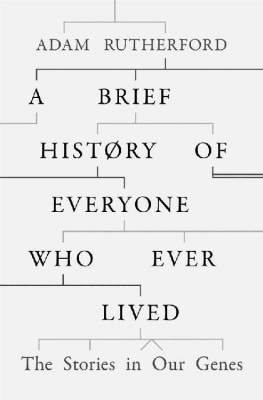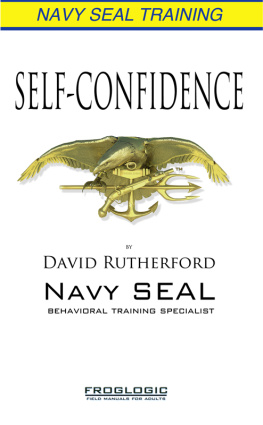Rutherford - The book of humans: the story of how we became us
Here you can read online Rutherford - The book of humans: the story of how we became us full text of the book (entire story) in english for free. Download pdf and epub, get meaning, cover and reviews about this ebook. City: London, year: 2018, publisher: Orion Publishing Group Ltd;Weidenfeld & Nicolson, genre: Romance novel. Description of the work, (preface) as well as reviews are available. Best literature library LitArk.com created for fans of good reading and offers a wide selection of genres:
Romance novel
Science fiction
Adventure
Detective
Science
History
Home and family
Prose
Art
Politics
Computer
Non-fiction
Religion
Business
Children
Humor
Choose a favorite category and find really read worthwhile books. Enjoy immersion in the world of imagination, feel the emotions of the characters or learn something new for yourself, make an fascinating discovery.
- Book:The book of humans: the story of how we became us
- Author:
- Publisher:Orion Publishing Group Ltd;Weidenfeld & Nicolson
- Genre:
- Year:2018
- City:London
- Rating:5 / 5
- Favourites:Add to favourites
- Your mark:
- 100
- 1
- 2
- 3
- 4
- 5
The book of humans: the story of how we became us: summary, description and annotation
We offer to read an annotation, description, summary or preface (depends on what the author of the book "The book of humans: the story of how we became us" wrote himself). If you haven't found the necessary information about the book — write in the comments, we will try to find it.
The book of humans: the story of how we became us — read online for free the complete book (whole text) full work
Below is the text of the book, divided by pages. System saving the place of the last page read, allows you to conveniently read the book "The book of humans: the story of how we became us" online for free, without having to search again every time where you left off. Put a bookmark, and you can go to the page where you finished reading at any time.
Font size:
Interval:
Bookmark:

THE
BOOK OF
HUMANS
THE STORY OF HOW WE BECAME US
ADAM RUTHERFORD

CONTENTS
By Alice Roberts
What a piece of work is a man! marvels Hamlet, in awe at our specialness.
How noble in reason! How infinite in faculty!
In form, in moving, how express and admirable! In action how like an angel!
In apprehension how like a god! The beauty of the world! The paragon of animals!
The paragon of animals is a lovely phrase. Hamlet exalts us as truly special, touching the divine, limitless in our thought. Its a prescient phrase too, as he raises us above other animals while acknowledging that we are one. Just over 250 years after William Shakespeare wrote those words, Charles Darwin irrefutably cemented humankinds classification as an animal the slightest of twigs on a single, bewildering family tree that encompasses four billion years, a lot of twists and turns, and a billion species. All of those organisms including us are rooted in a singleorigin, with a common code that underwrites our existence. The molecules of life are universally shared, the mechanisms by which we got here the same: genes, DNA, proteins, metabolism, natural selection, evolution.
Hamlet then ponders the paradox at the heart of humankind:
What is this quintessence of dust?
We are special, but we are also merely matter. We are animals, yet we behave like gods. Darwin sounds a bit like Hamlet, declaring that we have god-like intellect, yet we cannot deny that man and, to bring his language into the twenty-first century, woman carries the indelible stamp of his lowly origin.
This idea, that humans are special animals, is at the root of who we are. What are the faculties and actions that put us on a pedestal above our evolutionary cousins? What makes us animals, and what makes us their paragon? All organisms are necessarily unique, so that they can exist within and exploit their own unique environment. We certainly think of ourselves as pretty exceptional, but are we really more special than other animals?
Alongside Hamlet and Darwin comes a possible challenge to our ideas of human exceptionalism, from an arguably lesser piece of modern culture, the animated superhero film The Incredibles: Everyone is special... which is another way of saying that no one is.
Humans are animals. Our DNA is no different from anything that has lived in the last 4,000 million years. The coding system employed within that DNA is no different either: the genetic code is universal as far as we know. The four coded letters that make up DNA (known as A, C, T and G) are the same in bacteria and these incalculably numerous cells harvest energy from the rest of the universe in a process common to all of them.
These principles are three of the four pillars of biology: universal genetics, cell theory, and chemiosmosis, which is a rather technical yet elegant word for the basic process of cellular metabolism how cells draw energy from their surroundings, to be spent in the process of living. The fourth pillar is evolution by natural selection. Combined, these grand unifying theories coalesce to reveal something unarguable that all life on Earth is related by common ancestry, and that includes us.
Evolution is slow, and the Earth has been host to life for the vast majority of our planets existence. The timescales we talk about so casually in science are utterly baffling to comprehend. Even though we are a latecomer to life on Earth, our species is more We were physically capable of speaking then as we do today, and our brains were not significantly different in size. Our genes have responded in small part to changes in the environment and diets as we migrated within and out of Africa, and genetic variants account for the minuscule percentage of DNA that spells out the differences between individuals, changes in the most superficial characteristics skin colour, hair texture and a few others. But if you tidied up a Homo sapiens woman or man from 200,000 years ago, gave them a haircut and dressed them in twenty-first-century clothes, they would not look out of place in any city in the world today.
Theres a conundrum in that stasis. Though we may not look different, humans did change, and profoundly. Theres debate about when this transition occurred, but by 45,000 years ago, something had happened. Many scientists think that it was a sudden change sudden in evolutionary terms means hundreds of generations and dozens of centuries, rather than a thunderbolt. We dont quite have the language to relate to the timescales involved in such transitions. But what we can observe from the archaeological record is that we see the emergence and accumulation of a number of behaviours that are associated with modern humans, and there was a time before that where we seefewer or none of them. Given how long life has existed on Earth, this switch happened relatively in a heartbeat.
The transformation occurred not in our bodies or physiology or even in our DNA. What changed was culture. In scientific terms, culture refers broadly to the artefacts that are associated with a particular time and place. They include things like tools, blade technology, fishing gear, and use of pigment for decorative purposes or jewellery. The archaeological remains of a hearth show the ability to control fire, to cook, and maybe its position as a social hub. From material culture, we can infer behaviour. From fossils we can try to piece together what people looked like, but with archaeological evidence of the paraphernalia of our ancestors lives, we can address what people were like in prehistory, and when they became like that.
By 40,000 years ago, we were designing decorative jewellery and musical instruments. Symbolism in our art was rife, and we were inventing new weapons and hunting technology. Within a few millennia, we had fostered dogs into our lives tamed wolves that accompanied our search for food long before they became our pets.
The concatenation of these behaviours is sometimes referred to as the Great Leap Forward, as we jumped into a state of intellectual sophistication that we see in ourselves today. Alternatively, its a cognitive revolution, but I dislike the use of that phrase to describe a process which was both continuous and probably lasted a few thousand years or more real revolutions should be thunderbolts. Nevertheless, modern behaviour emerges permanently and quickly in several locations around the world. We began to carve complex figurines, both realistic and abstract, sculpted make-believe chimeras out of ivory, and we adornedcave walls with pictures of hunts, and of animals important to our lives. The earliest piece of figurative art by Homo sapiens that we know of is a 40,000-year-old twelve-inch statue of a lean man with the head of a lion. It was carved from a mammoth tusk during the last Ice Age.
Soon after that time we were making small statues of women. They are known today as Venus figurines. We dont know if there was a specific purpose to these dolls, though some researchers think they may have been fertility amulets, as their sexual anatomy is exaggerated: bosomy women with swollen labia, and often bizarrely small heads. Maybe they were just art for arts sake, or toys. Either way, to create such sculptures requires great skill and foresight, and a capacity for abstract thought. A lion-man is an imagined being. The Venus amulets are deliberate misrepresentations, abstractions of human bodies. These figures cannot exist in isolation either: artisan craft requires practice, and though today only a handful of these beautiful works of art remain, they must represent an iterative process, a lineage of skilled craftspeople.
Font size:
Interval:
Bookmark:
Similar books «The book of humans: the story of how we became us»
Look at similar books to The book of humans: the story of how we became us. We have selected literature similar in name and meaning in the hope of providing readers with more options to find new, interesting, not yet read works.
Discussion, reviews of the book The book of humans: the story of how we became us and just readers' own opinions. Leave your comments, write what you think about the work, its meaning or the main characters. Specify what exactly you liked and what you didn't like, and why you think so.

